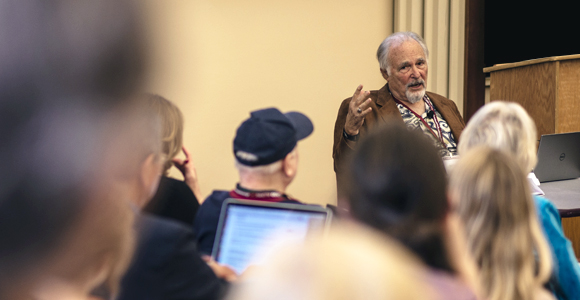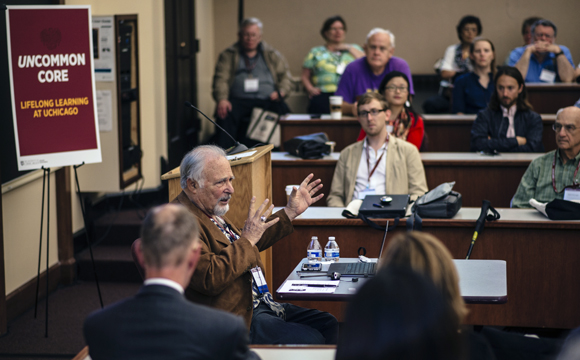
Psychology
Don’t lie to me
Paul Ekman, EX’52, explains his research on microexpressions.
Anne Ford, AM’99
Poker faces have no point around Paul Ekman, EX’52. As the codiscoverer of “microexpressions”—brief involuntary facial expressions that indicate the conscious or unconscious concealment of a feeling—the professor emeritus of psychology at the University of California, San Francisco, can spot even the most well-hidden emotion. His work inspired the Fox TV show Lie to Me (2009–11). More recently he served as a consultant on the 2015 Pixar film Inside Out.

How did you become interested in studying emotion?
My mother killed herself when I was 14. She told me she was going to do it, she asked me to save her, and I couldn’t. I didn’t know what to do. So I made the decision to dedicate my life to developing knowledge that would help people like her in the future.
It was only a year later that you enrolled at the University of Chicago.
Yes. At that time, they would take you after two years of high school, which was fortunate, because I couldn’t deal with high school, and it couldn’t deal with me. I was questioning authority way before it became a bumper sticker. At the University, that behavior was highly approved of.
After three years there, I had an argument with my father. He wouldn’t give me any more money, and I couldn’t afford the tuition. So I moved to New York and got a job on the waterfront. Eventually I got my bachelor’s degree at New York University, and then my PhD in psychotherapy at Adelphi University.
Then I got drafted into the Army, and the Army changed me from a would-be psychotherapist to a would-be researcher. Because I found that through research, I could change Army practices and make them more humane.
The main thing I did was to prove that there was a huge decrease in recidivism if soldiers who went AWOL were given just three hours a day of extra-hard labor, rather than a month in the stockade. As a consequence, they stopped sending people to the stockade, and I thought: “My God, you can change the world with research.”
How did your work with microexpressions come about?
It was after I was asked to teach a class to a group of psychiatric trainees. They wanted help identifying when hospitalized psychiatric patients were lying about having suicidal intent.
I watched a film of one of these patients, a woman who had been hospitalized after a suicide attempt. It turned out that she was lying to her doctors about feeling better in order to get free of hospital supervision, so that she could try again to take her life.
To me, she looked like she was in good shape mentally. But since I knew she was really planning suicide, I took a look at the film in slow motion. And that’s when I first saw a microexpression. Several of them, actually. They were of anguish.
How accurate are you personally at detecting microexpressions?
Deadly. People are often nervous around me for that reason. I tell them, “I can only tell how you’re feeling, not what you’re thinking. All those nasty, dirty thoughts you have? They’re private.” That’s very reassuring to people.
If I see a microexpression on my daughter’s face, I might say, “Is there something you’re feeling that you’re reluctant to talk to me about?” If I see one on my wife’s face, I’ll say nothing, because I know she gets upset when she thinks I’m spotting her concealed emotions. You have to give people at least the impression that they have privacy.
You’ve also done research into something called “emblematic slips.”
Every culture has symbolic gestures, like the A-OK sign. Sometimes those gestures occur like a slip of the tongue, without the awareness of the person making them.
I discovered this while I was filming some interviews, in which I had the head of a department grill some graduate students in a rather unfriendly way. And one of them gave him the finger—not up in his face, but with her hand still on her skirt. When I told her she had done it, she denied it, and the professor didn’t see it either, but my film captured it.
In recent years, you report, your own emotional life has changed, in part due to some discussions you’ve had with the Dalai Lama about emotions.
Since I met with him, I’ve become a much less angry person. I think that’s primarily a consequence of being able to resolve some unresolved feelings about my father. You know, now that I think about it, I’ve had a good life, I’m pleased with what I’ve been able to accomplish, and if I had had normal parents, maybe I wouldn’t have been motivated to do that.
No, I don’t recall ever seeing any microexpressions on the Dalai Lama’s face. He’s not a concealer.
